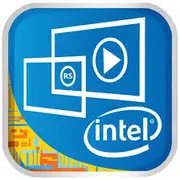Intel Core m3-7Y30

Intel Core m3-7Y30 in 2025: Is This Processor Worth Choosing for an Ultrabook?
Introduction
Even in 2025, Intel Core m3 processors remain popular in budget ultrabooks and compact devices. The Intel Core m3-7Y30, released back in 2017, is still found in new entry-level laptops. But how relevant is it? Let's explore who this chip is suitable for and what tasks it can perform.
1. Architecture and Process Technology: Kaby Lake in the Age of 3nm Technologies
The Intel Core m3-7Y30 is built on the Kaby Lake architecture (7th generation) with a 14nm process technology. It is a dual-core CPU with Hyper-Threading support, providing 4 threads. Clock speeds are as follows:
- Base: 1.0 GHz
- Turbo Boost: up to 2.6 GHz (during short bursts of load).
Integrated graphics – Intel HD Graphics 615 with 24 execution units (EU) and a clock speed of 300–900 MHz. This is a weak iGPU even by 2025 standards, but it is sufficient for basic tasks.
Architecture Features:
- Supports DDR3L/LPDDR3 and LPDDR4 (up to 16 GB of RAM);
- 4 MB of L3 cache;
- Intel Speed Shift and Quick Sync Video technologies for rapid frequency switching and video decoding.
2. Power Consumption and TDP: Why is 4.5W an Advantage?
The processor's TDP is 4.5W, which allows for passive cooling. This is a key reason why the m3-7Y30 is still found in ultra-thin laptops:
- Low heat generation = silent operation;
- Ability to create devices less than 1 cm thick.
Energy-saving Technologies:
- Intel SpeedStep – dynamic voltage and frequency management;
- C-States – reduced power consumption during idle;
- "Fanless" mode – no fan saves battery charge.
3. Performance: What Can You Do with the Core m3-7Y30?
Geekbench 6 (2025 test):
- Single-Core: 768;
- Multi-Core: 1481.
Real-World Scenarios:
- Office Work: Google Docs, Excel, Zoom – no issues. However, simultaneous running of 10+ tabs in Chrome may lead to lag.
- Multimedia: 4K video playback (thanks to VP9 and H.265 decoding). Editing in DaVinci Resolve is only suitable for short 1080p clips.
- Gaming: Only light projects – Minecraft (30–40 FPS on minimum settings), Stardew Valley, older games like Half-Life 2.
Turbo Boost: In turbo mode, the processor speeds up to 2.6 GHz, but only for 10–15 seconds. This is inefficient for prolonged loads (such as rendering).
4. Use Cases: Who Is This Processor Suitable For?
- Students – for lectures, text work, and web surfing.
- Office Workers – if heavy software like AutoCAD is not needed.
- Users on-the-go – compact laptops with 8–10 hours of battery life.
Not Suitable For:
- Gamers;
- Video Editors;
- Programmers working with Docker or virtualization.
5. Battery Life: How Does TDP Affect Runtime?
Laptops with the Core m3-7Y30 are equipped with batteries ranging from 35–45 Wh. In real-world conditions, this results in:
- 8–10 hours when working with documents;
- 5–6 hours during streaming (YouTube, Netflix).
Tip: For maximum battery life, choose models with Full HD IPS screens (not 4K) and SSDs with 256 GB or more.
6. Comparison with Competitors: What Do AMD and Apple Offer?
- AMD Athlon Silver 7120U (2024, 4 cores, 4.5W): Better in multi-threaded tasks (Geekbench 6 Multi-Core ~1800), but pricier ($400–$500).
- Apple M1 (2020): 2–3 times higher performance, but M1 laptops start at $700.
- Intel Core i3-1215U (2024, 6 cores, 15W): More powerful in multitasking but requires active cooling.
Conclusion: The Core m3-7Y30 falls behind modern alternatives but wins on price. New laptops with this CPU cost $300–$400.
7. Pros and Cons: When to Choose and When to Pass?
Strengths:
- Low power consumption;
- Silent operation;
- Affordable price.
Weaknesses:
- Weak multi-threaded performance;
- Outdated architecture (no support for PCIe 4.0, Thunderbolt 4);
- Limited upgrade options (memory is often soldered).
8. Recommendations for Choosing a Laptop
Types of Devices:
- Ultrabooks: For example, Chuwi Minibook X (2025) – 8.9” screen, weight 800g, price $350.
- Hybrid Laptops: HP Pavilion x360 11-inch (price $400) with a touchscreen.
Things to Consider:
- RAM Size: At least 8 GB (preferably 16 GB for Windows 11);
- Storage Type: Only SSD (256 GB and above);
- Ports: USB-C with charging support, HDMI for projectors.
9. Final Conclusion: Who Is the Core m3-7Y30 Suitable For?
This processor is a choice for those who value portability and battery life but are not willing to pay for modern chips like the Apple M2 or Intel Core i3-N300. It is suitable for:
- Working with texts and spreadsheets;
- Watching movies and video calls;
- Using while on the move (lightweight, no fan).
Key Benefits:
- Laptops with the Core m3-7Y30 are the most affordable in the ultrabook category (starting from $300);
- Battery life is sufficient for a full workday.
If your budget is tight and your tasks are simple, this is a worthy option. However, for future-proof solutions, it's better to consider processors from 2024-2025.
Basic
CPU Specifications
Memory Specifications
GPU Specifications
Miscellaneous
Benchmarks
Compared to Other CPU
Share in social media
Or Link To Us
<a href="https://cputronic.com/en/cpu/intel-core-m3-7y30" target="_blank">Intel Core m3-7Y30</a>